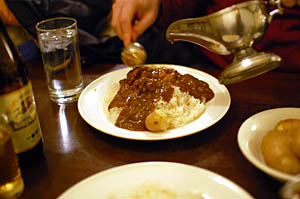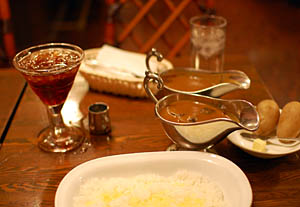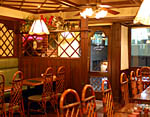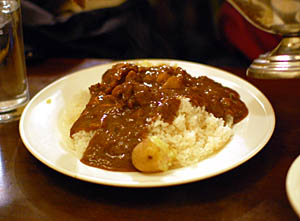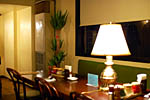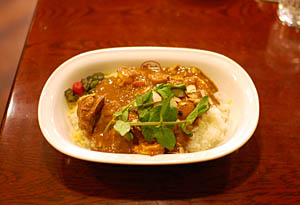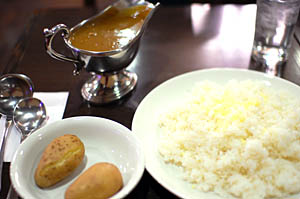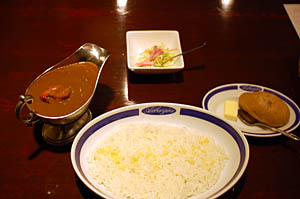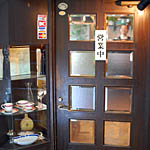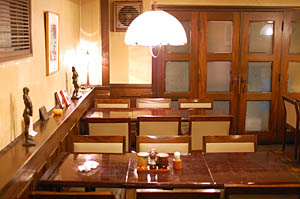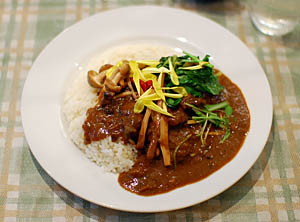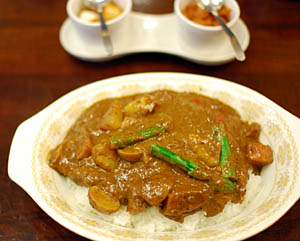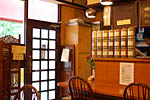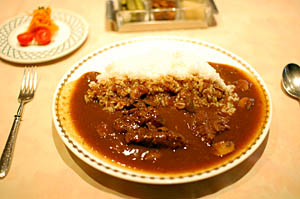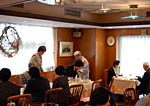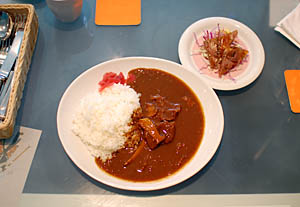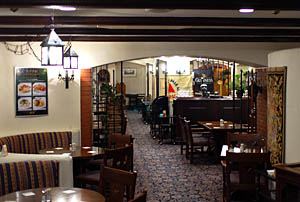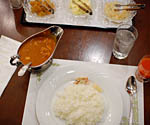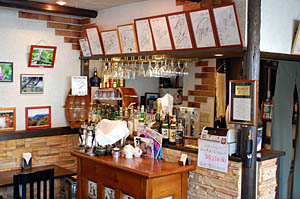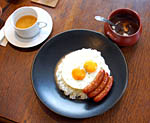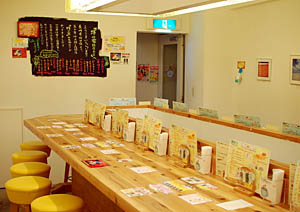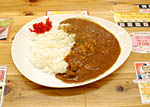European-style specialty shops
|
Perusona (Jimbocho)
Perusona serves top-quality European-style curries, and two- and three-ingredient combination curries are easy to order. We opted for eggplant, chicken and beef (Y1400) on a recent visit - the sauce was richly spiced and on the sweet side, while the beef was lean and very tender. The eggplant is a nice option, adding some balance to the ubiquitous meat ingredients. The spacious second-floor dining room is done up in classic kissaten style, with Brazilian easy-listening music in the background.
[data]
|
|
Petit Feu A La Campagne (Hanzomon)
This off-the-beaten-track shop on a Hanzomon side street serves some of Tokyo's better European-style Japanese curries. The mixed curry with chicken, pork and beef is especially recommended - the meats are tender and skillfully prepared, the sauce rich and spicy. Curries come with a good-size helping of boiled potatoes. The coffeeshop decor is nicer than average, although it can get smoky when crowded.
[data]
|
|
Bondy (Jimbocho)
The curry sauce here is scrumptious, with a natural fruit sweetness, well-balanced spices and complex flavors. There aren't many mixed-ingredient options, but the shrimp, clam and chicken was quite good, with plump shrimps and juicy, flavorful clams. It also came with button mushrooms, almonds and a sprig of watercress on top - a nice touch - plus umeboshi and a couple of sweet and delicious potatoes on the side. The entrance is through a used bookstore - take the far right-hand aisle. Bondy gets extra points in our book for being open all afternoon.
[data]
|
|
Bon Appetit (Mita)
An old standby in the Mita neighborhood, this long-running basement shop has solid wood furniture, stucco walls, odd little paintings and soft jazz in the background. The roux here is okay, but the quality of the meat really stands out - nice lean pork and very tasty and tender chicken. The mixed meat or all-chicken options are recommended. The boiled potatoes are also quite good.
[data]
|
|
Aubergine (Yotsuya)
A popular spot for local Yotsuya diners, Aubergine offers a good assortment of European-style Japanese curries, including two-ingredient combination platters. The shrimp and chicken combo (Y1580) had a sweetish, rich sauce; ample portions of well-prepared chicken; plump, flavorful shrimps; mushrooms and a tiny quail egg. Curries come with excellent homemade cole slaw. There are two other branches (Mita and Tsukiji), and together they deliver through large swaths of Tokyo.
[data]
|
|
Gavial (Jimbocho)
This large traditional coffeeshop plays classical music and specializes in European curries and espresso. Curries include scallops and several other seafood variations along with the usual beef, pork and chicken, but it's not as easy to put together your own combination as at some other places. We tried the mix of shrimp, asari clams and chicken, which had juicy shrimp and nice mushrooms, but the hot (karakuchi) version was just a little too fiery to let us appreciate the subtleties of the spices - we'd recommend sticking to the mild setting. The boiled potatoes were sweet and very tasty, but our smoked salmon and endive salad was overly ambitious. Curries are priced Y1100-1700.
[data]
|
|
Petit Feu (Hongo)
The curries here are unusual and fairly tasty, but unfortunately the potato we were served was really sad-looking and unappetizing, and part of it was sliced off for some reason. Let's just say it wasn't something you'd expect to be served in a restaurant. Too bad, because our "yakuzen" curry, made with medicinal herbs, mushrooms and tasty greens and strewn with flower petals, was really interesting, a good match for the pale ale from the Kirin Europe series. Curries from Y850.
[data]
|
Yoshoku restaurants
|
Tomato (Ogikubo)
This small neighborhood yoshoku-ya serves "European stews and English curries." Curry sauces are built on a fond de veau base and incorporate some 36 different spices, all on display on the shop's counter. The flavor of the curry is rather unique and very appealing - similar to other European-style Japanese curries but with an intriguing hint of medicinal herbs. We enjoyed a mild, "creamy" Hokkaido veal curry, and we highly recommend the seasonal vegetable option (Y300 extra), which features around ten different vegetables such as asparagus, okra and lotus root. There's also a popular beef-tongue curry, which might be an even better match for the rather assertive sauce. Y2000 for veal curry with extra vegetables and dessert.
[data]
|
|
Dom Pierre (Kyobashi)
One of Japan's more famous yoshoku establishments, the decor here is 1960s-modern, with wood paneling and a big dessert cart. Our beef curry (a specialty of the house) was very tasty, with tender meat and mushrooms and flavors that blended together smoothly and gently. It seemed more like beef stew than a typical Japanese curry, though, the roux more like a rich gravy with a bit of curry flavor. It was accompanied by a small salad of baby tomatoes and carrots (good) and cornichons (not really a good match). The beef curry is Y1890, and beef fried-rice omelettes are Y2625.
[data]
|
|
Loup de Mer (Kanda)
Loup de Mer proves that good yoshoku cuisine needn't be stuck in a time warp. Our lunchtime Hokkaido beef curry (Y1100) was accompanied by a very appetizing salad of head cheese and red-cabbage slivers. The hunks of beef were tender, lean and very flavorful, beautifully complemented by the curry sauce, rich but with a bracing tanginess. The soft but still slightly crunchy deep-red pickles were excellent, with an almost cherry-like flavor. Unlike most yoshokuya, the decor here won't make you sigh with nostalgia - the dining room is done up in a tasteful pastel color scheme from the current century. Chef Suzuki is a veteran of the famous Dom Pierre yoshoku establishment, and the menu also covers standards like hayashi rice and rice omelettes, and even offers tasting menus at Y5,000 and Y10,000.
[data]
|
Other curry shops
|
Ivy House (Otemachi) (CLOSED)
This hotel whiskey bar turns into a curry specialty shop at lunchtime (weekdays only), with exotic variations like fresh fruit curry (papayas, apples, kiwi and pineapple) and Russian crabmeat curry. Curries are served with fruit juice and six condiments in tiny glass bowls; the marinated wiener slices are compelling. Our free-range chicken curry had lots of white-meat chicken in a spicy tomato-based sauce. For our taste we found it a little too similar to Indian curry, without actually being Indian curry. The decor is old-fashioned Tokyo hotel style, with brick archways and wrought-iron chandeliers. Prices range from Y1300-2500.
[data]
|
|
Hutte Manx (Yoyogi)
At lunchtime this neighborhood coffee shop serves a dazzling assortment of "British-style" curries, with variations like smoked pork and egg; mushroom, clam and egg; and smoked chorizo sausage and egg. We tried the special demi-glace version, and the recipe seems to be rather heavy on one spice - cloves perhaps - very different in character from the usual European curry interpretation and a little unbalanced for our taste. In the evenings Hutte Manx is a bar specializing in single-malt whiskeys.
[data]
|
|
Hachinoya (Higashi-Ginza)
The original Hachinoya opened in Kyushu in 1951, and moved to Ginza only a few years ago. Tasty beef, chicken and vegetable curries and hayashi rice are Y700 each, and there's a mega-large option for Y1600 that's 2.5 times ordinary size. For variety there's a crab croquette topping (Y250), Chinese pork bun with Pu-erh tea (Y550), and chocolate curry (Y980). The attractive counter-only basement shop is non-smoking.
[data]
|
by Robb Satterwhite
|

